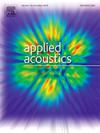Wideband raypath separation based on covariance matrix reconstruction
IF 3.4
2区 物理与天体物理
Q1 ACOUSTICS
引用次数: 0
Abstract
The application of covariance matrix reconstruction based algorithms is motivated by the need to improve the separation accuracy of the grid-dependent compressive sensing method in the presence of grid mismatch. However, the existing published literatures are focused on the detection of narrowband acoustic signals (or raypaths). In this paper, a wideband covariance matrix construction based algorithm is proposed for the separation of wideband raypaths. First, a wideband covariance matrix model is developed to recover the Toeplitz matrix, which possesses low-rank and positive semi-definite (PSD) properties. The separation of raypaths is then achieved from the recovered matrix by applying a conventional subspace-based method. Results from simulation and tank experiment demonstrate that the proposed algorithm offers several advantages: (1) it enables the identification of wideband and coherent raypaths with high resolution, particularly when arrival times are close; (2) it significantly improves accuracy in the presence of grid mismatch, due to the absence of a predefined grid; and (3) it allows the detection of more raypaths than can be identified through the direct application of the interspectral matrix.
求助全文
约1分钟内获得全文
求助全文
来源期刊

Applied Acoustics
物理-声学
CiteScore
7.40
自引率
11.80%
发文量
618
审稿时长
7.5 months
期刊介绍:
Since its launch in 1968, Applied Acoustics has been publishing high quality research papers providing state-of-the-art coverage of research findings for engineers and scientists involved in applications of acoustics in the widest sense.
Applied Acoustics looks not only at recent developments in the understanding of acoustics but also at ways of exploiting that understanding. The Journal aims to encourage the exchange of practical experience through publication and in so doing creates a fund of technological information that can be used for solving related problems. The presentation of information in graphical or tabular form is especially encouraged. If a report of a mathematical development is a necessary part of a paper it is important to ensure that it is there only as an integral part of a practical solution to a problem and is supported by data. Applied Acoustics encourages the exchange of practical experience in the following ways: • Complete Papers • Short Technical Notes • Review Articles; and thereby provides a wealth of technological information that can be used to solve related problems.
Manuscripts that address all fields of applications of acoustics ranging from medicine and NDT to the environment and buildings are welcome.
 求助内容:
求助内容: 应助结果提醒方式:
应助结果提醒方式:


